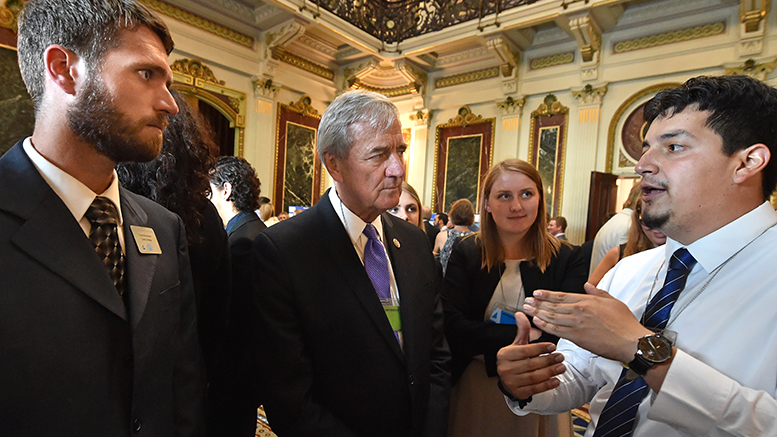Barrett Williams could hardly believe it. Last semester, he was in an Engineering 101 course at Ohlone College in Freemont, California, when he joined a team of students that wanted to participate in a National Science Foundation (NSF) competition to find innovation STEM solutions for real-world problems.
Last Wednesday, Williams and his team were in Washington, D.C., pitching to White House officials, the National Science Board and members of Congress a system they developed that uses drones and nanoparticle detection to find land mines.
“It’s surreal,” he said.
Williams’ team was among the 10 selected as finalists for the Community College Innovation Challenge, an annual program sponsored by NSF in partnership with the American Association of Community Colleges. The teams comprised students and a faculty advisor who worked on innovations that ranged from thermal electric solar water heaters for the homeless and an app to help military service members cope with stress, to using waste water to generate electricity and an affordable knee brace.
Loaded with info
Prior to their presentations at the Eisenhower Executive Office Building (which houses most of the White House staff), the teams heard from communications and marketing experts to help them hone their skills on pitching their products to potential investors and customers. Williams said he found it especially useful to learn about taking a product and redesigning it for what customers want based on their feedback.
Marco Flores, a student at Los Angeles Mission College in California — whose team worked on producing electricity from wastewater with microbial fuel cells — said the mock interviews at the boot camp were enlightening. The questions were tough and prompted the team to reflect on the product and “think about things we didn’t consider,” he said.
David Lin, the faculty advisor for the Northern Virginia Community College team — which developed a platform to connect volunteers who have expertise in certain areas with individuals who need that expertise after a disaster — said he was impressed by how far his team and the other squads developed over the course of four days at the camp.
“No one is leaving here without some great takeaways,” he said. “I’m learning myself, right along with them.”
This year also marked the first time that the selected teams had a chance to talk directly to members of the National Science Board. For more than an hour the students and their advisors conversed with board members on myriad issues, from college affordability to apprenticeships.
And the winner is….
On the last day of the CCIC event, the teams made their final pitches to a panel of judges that included scientists, entrepreneurs and investors. Much like the TV show “Shark Tank,” the students presented their products to the judges, who queried them about costs, profit margins, liability issues, potential competitors and partners, and more.
In the end, Western Dakota Tech’s project to use aquaponics — tapping symbiotic relationships between plants and fish — to help reduce hunger took first place. Oakton Community College in Illinois was runner up with its invention to recover heat and suppress noise from trucks’ exhausts.
Another benefit for the participating teams was the chance to network with one another. Although it was a competition, they were encouraging each other and even applauding other teams’ final presentations, which included a five-minute pitch followed by a brief Q&A with the judges. During a reception afterward, students were exchanging phone numbers and emails and hugging each other goodbye.
“That was phenomenal,” said Mission College’s Flores.

Photo: Matthew Dembicki

